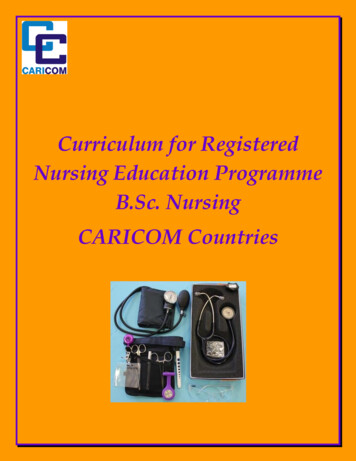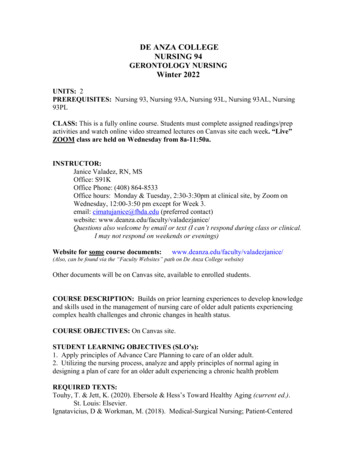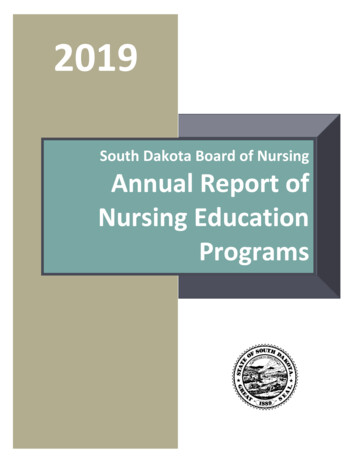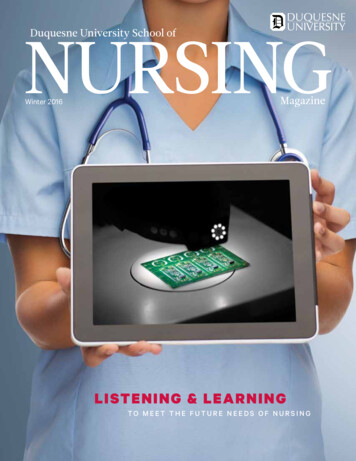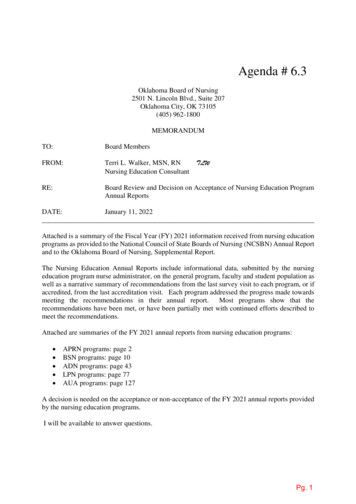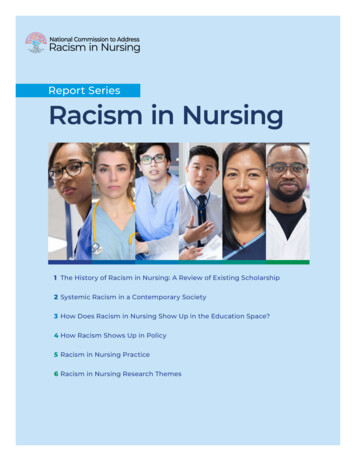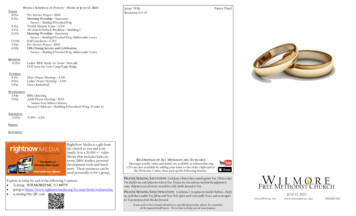
Transcription
WELCOME TO THECHILDREN’S MINNESOTA 2020NURSING ANNUAL REPORT.Enclosed you will find the amazing contributions Children’sMinnesota nurses made to nursing practice and how they haveadvanced the nursing professional practice model, REACH, onbehalf of our patients and families.Coming to Children’s Minnesota as Chief Nursing Officer inearly 2021, I have admired the strength and determinationour nurses have to putting Kids First. The 2020 NursingAnnual Report highlights the resiliency and commitmentChildren’s Minnesota nurses have to their patients andprofession. A tremendous amount of change was experiencedin 2020 at Children’s Minnesota, including a transition innursing leadership. The stories highlighted in the report make me so proudand humbled in my role as Chief Nursing Officer. It captures the ongoingdedication of our nurses even during significant change — including ourresponse to the COVID-19 pandemic and civil unrest right in our own backyard.Because of the remarkable work of our nurses, the kids and families in thecommunities we serve have continued to trust us in caring for them when theyneed us the most.As you peruse the report and would like to learn more, don’t hesitate to reachout with your thoughts and ideas as we navigate towards the future together.Thank you,Caroline Njau, MBA, BSN, RN, NEA-BCChief Nursing Officer and Senior Vice President, Patient Care Services2020 NURSING ANNUAL REPORT
NURSING2020 Annual Report
TABLE OF CONTENTSLetter from the Chief Nursing Officer 5About Children’s Minnesota 6Nursing at a Glance 7Chief Nursing Officer, Pam VanHazinga, retires 8Children’s Minnesota nurses rise to the challenge of global pandemic 10Partners in Care 12Dedicated Children’s Minnesota nurses through the civil unrest riots 14Nurses of Color ERG supports the community 16Summer internship supports future Children’s Minnesota nurses 17Nurse-led book club aims to address racism in health care 18Preceptor development program 20Advancing Excellence 22National guidelines for caring for neonatal patients with infections 24CRNA’s COVID-19 experience leads to national conferences 25Conversion to virtual nursing orientation 26Evidence-based practice projects in process 28Shared Governances 30Development of the Nursing Performance Improvement Council 32Professional nursing certification expands to virtual opportunity 33PTAP accreditation with distinction 34Associate Medical Directors APRNs 36Nursing Care Delivery 38Sepsis performance improvement leads to better patient outcomes and improved tools 40Development of the Nursing Care Delivery policy 4122020 NURSING ANNUAL REPORT
Ambulatory phone triage nurses successfully adapt to their remote work environment 42Children’s Minnesota responds, redesigns and reimagines the patient care experiences 43Awards and Recognition 44Honoring nurses with the DAISY Award 46Medical Education Nurse Teaching Award 47Nurses Week Award 47Excellence in Patient- and Family-Centered Care Award 2020 48APHON New Author Award 48National Association of Neonatal Nurses 2020 Award 48Minnesota Board of Nursing Appointment 49Minnesota’s Pediatric Nurse Practitioner of the Year 49Notable Heroes in Health Care 2020 50Nursing scholarships 50Wellness group motivates NICU staff in countless ways 51Transition out of Practice 52Professional Achievements 54New degrees 54New certifications 54Regional and national conference podium presentations 56Regional and national conference poster presentations 57Podcasts and webinars 57Publications 582020 NURSING ANNUAL REPORT3
I’m extremely proud of how ournursing team handled themselvesin an often-uncertain environmentas we learned to navigate thecomplexities of the pandemic whilecontinuing to care for our patients.42020 NURSING ANNUAL REPORT
This year has brought many unforeseen challenges to Children’s Minnesota as wecontinue to battle the COVID-19 pandemic. We have seen many changes as anorganization as we’ve adapted to what our patients and community need in this tryingtime. I’m extremely proud of how our nursing team handled themselves in an oftenuncertain environment as we learned to navigate the complexities of the pandemicwhile continuing to care for our patients. Our nurses fulfill many roles outside of caregivers: they’re advocates,teachers, champions, innovators, leaders and partners and more. I am excited to share the 2020 Children’sMinnesota Nursing Annual Report, which showcases the incredible role that nurses and their contributions playin influencing nursing practice and care for the diverse needs of the children we serve.Our professional practice model, REACH, focuses on several components. As you read the stories in the pagesof this annual report, you’ll find a connection in at least one of the foundational elements: advancing excellence,shared governance, partners in care, nursing care delivery and The Children’s Way.In addition to REACH, these stories also reflect our 2020 strategic plan initiatives, which include: Advancing a culture of safety Delivering equitable patient care Strengthening communication Increasing caregiver resiliency Supporting our clinical programs Improving our processes and efficiency Promoting professional nursing developmentWhile the 2020 annual report embodies a lot of the amazing work that takes place at Children’s Minnesotaevery day, it’s only a small snapshot of what our nurses tirelessly contribute. They continue to amaze and inspireme every day.After 20 years at Children’s Minnesota, which have been among the most rewarding of my career, I am retiringto refocus my time and energies on family and interests outside of my role as chief nursing officer (CNO). Icherish the opportunity I have been given to serve as your CNO. I am thankful for the support, ideas, feedbackand encouragement I have received from you and have every confidence that my successor will experience thesame.As we move into 2021, we all look forward to a future with hope. The nursing team will partner with the entireorganization as we care for the most amazing people on Earth — kids.With grateful and sincere regards,Pam VanHazinga, MBA, BSN, RNChief Nursing Officer and Senior Vice President Patient Care Service2020 NURSING ANNUAL REPORT5
CHILDREN’S MINNESOTA OVERVIEWWe champion the health needs of childrenand families. We are committed toimproving children’s health by providingthe highest-quality, family-centered care,advanced through research and education.Children’s Minnesota mission statementChildren’s Minnesota is one of the largest freestanding pediatrichealth systems in the U.S., and the only health system in Minnesotato provide care exclusively to children — from before birth throughearly adulthood. An independent and not-for-profit systemsince 1924, Children’s Minnesota serves the Upper Midwest attwo hospitals, 12 primary care clinics, six rehabilitation and ninespecialty care sites.Children’s Minnesota Minneapolis CampusAt Children’s Minnesota, we bring together more experts acrossmore specialties than any other hospital system in the Midwest. Asthe region’s largest pediatric program, we partner every day withclinicians across the Midwest to bring world-class care to the mostamazing people on Earth — kids.Trusted, nationally recognized careChildren’s Minnesota is regularly recognized and awarded nationallyfor excellence in care, quality, innovation and industry leadership. In 2018, we were the first and only hospital in Minnesota verifiedas a Children’s Surgery Center by the American College ofSurgeons — the highest distinction for health systems thatperform complex surgical procedures for newborns, childrenand teens.Children’s Minnesota St. Paul CampusWE CARE FORMORE KIDS THANANY OTHER HEALTHSYSTEM IN MNOVER HALFOF BEDS SYSTEMWIDE DEDICATED TOCRITICAL CARE62020 NURSING ANNUAL REPORT We earned Magnet recognition from the American NursesCredentialing Center — the most prestigious distinction a healthorganization can receive in nursing excellence and high-qualitypatient care.2VERIFIED TRAUMACENTERS We’re consistently ranked among the top hospitals byU.S. News & World Report. We’re Minnesota’s only Level I pediatric trauma center in ahospital dedicated solely to kids.
NURSING AT A GLANCETotal Number of NursesAPRNs244RNsRNAPRNNurse turnover (Avg.)11.11%10.58%Nurse vacancy (Avg.)2.38%4.34%13.33 years9.53 yearsNurse tenure (Avg. length of employment)1,54897RN Length of Service254APRN Length of Service86318230031901 yr or less5639341-3 yrs3-5 yrs5-10 yrs10 yrs1 yr or lessPercent of RNs with Baccalaureate or Higher81.11-3 yrs81.53-5 yrs82.05-10 yrs10 yrs82.479.179.580.6Q2 2019Q3 2019Q4 2019Q1 2020Q2 2020Q3 2020Q4 202027.726.426.726.227.8Q4 2019Q1 2020Q2 2020Q3 2020Q4 2020GOAL80%78.6Q1 2019Percent of all RNs Certified24.324.2Q2 2019Q3 2019GOAL28.2%19.8Q1 20192020 NURSING ANNUAL REPORT7
CHIEF NURSING OFFICER, PAM VANHAZINGA, RETIRESPam was a strong advocate for nursing diversity andinclusion. In early 2019, she partnered with St. CatherineUniversity to create the Nursing Diversity Collaborative.The goal is to increase workforce diversity by focusingon improvements in institutional climate, innovativerecruitment and retention strategies, and increasedsupport and job satisfaction for nurses of color. Pamalso shared strategies to address implicit bias in nursingorientation and education through a programmaticapproach with simulation. Addressing biases providesnurses with the tools and skills needed to not onlyaddress nursing diversity and inclusion, but to alsoimprove the patient experience.After 20 years at Children’s Minnesota, and almostthree of those years as Chief Nursing Officer (CNO),Pam VanHazinga, MBA, BSN, RN, retired at the endof December. Known for her relentless supportfor children and their families, Pam led nurses andthe organization through operational changes,technology enhancements, staffing adjustments anda worldwide pandemic.Pam’s leadership style consistently demonstratedgratitude and awe for the nurses she felt privilegedto lead by always expressing pride in the nursing caregiven to children and their families. Pam routinely andauthentically praised Children’s Minnesota nurses asexceptional and second to none. As a patient caremanager, director, senior director and CNO, Pamformed trusting, collaborative relationships where shepositively influenced projects and initiatives throughher experience and knowledge in clinical practice,financial management and strategy development.These strong relationships also extended to themedical staff, community and academic partnersthrough promotion of evidence-based practices,nursing research and servant leadership.82020 NURSING ANNUAL REPORTDedicated to quality and patient safety, Pam creativelyexpanded the role of the patient care supervisor toassess nursing practices and improve patient outcomes.It was important to Pam to make data-driven decisions.She guided several report and dashboard initiatives,including the nursing dashboard, tracking turnover ratesand diverse hiring trends. Pam continually monitoredand responded to trends in results at Children’sMinnesota including census, patient experience andnursing-sensitive indicators.Pam shared her pride in Children’s MinnesotaMagnet designation, especially at the 2018 Magnet conference. She was thrilled to spend time with theclinical nurses, learning from their experiences andideas, including endorsing the telebuddy program. Pamsupported ongoing education and professional nursingcertification as Children’s Minnesota reached the targetof 80% baccalaureate in nursing degree completionunder her leadership. Pam was a strong advocate fornurses and demonstrated nursing influence at all levelsof the organization.Pam had a remarkable nursing career. She is describedas a calm, courageous and collaborative leader guidinggrowth at Children’s Minnesota and working to raise thebar for pediatric health care in the region. Pam touchedmany people including nurses, patients, families,colleagues and the community. Children’s Minnesotais richly appreciative for the leadership and dedicationPam gave over the last 20 years.
We wish you well in your retirement. You will be missed.2020 NURSING ANNUAL REPORT9
CHILDREN’S MINNESOTA NURSES RISE TO THECHALLENGE OF RESPONDING TO A GLOBAL PANDEMICThe introduction of COVID-19 in January 2020presented a number of challenges to health careorganizations across the world. In the early stages ofthe pandemic, there were many unknowns with themost critical being how to safely care for patientssuspected or confirmed to have COVID-19. AtChildren’s Minnesota, nurses were at the forefront ofthe response to the pandemic and continue to lead theway by creating innovative ways to protect patients andhealth care workers.Supply ConservationHICS Team DevelopmentTo keep Children’s Minnesota staff and patients safe,with limited access to critical resources, the infectionprevention nurses:Children’s Minnesota enacted the Hospital IncidentCommand System (HICS) to guide the hospital’splan and response. The infection prevention team,comprised of three seasoned nurses with several yearsof experience in managing outbreaks, immediatelyassumed leadership roles on the HICS team: PatsyStinchfield, MS, APRN, CPNP, CIC, Senior Director ofInfection Prevention and Control; Adriene Thornton,MA, RN, CIC, Infection Preventionist; and Wendy Berg,BSN, RN, CIC, Infection Preventionist. The goal of theHICS team was to command, control and coordinatea response to COVID-19 and provide a means tocoordinate the efforts of individual departments. Thehigh-level goal was to stabilize the incident and protectlife, property and the environment.102020 NURSING ANNUAL REPORTIn March 2020, it became apparent that one of theimmediate challenges health care organizationswould face was the lack of supplies including personalprotective equipment (PPE) such as masks, gowns,hand sanitizer and disinfectants. In particular, N-95masks and face shields were low in supply and high indemand. At one point, there was not enough Avagardhand sanitizer for patient rooms, leaving only onecontainer at the door entrance. Created multidisciplinary ad hoc teams todevelop recommendations for PPE use based onguidance from the Centers for Disease Control andEpidemiology (CDC). Developed guidelines for parents and caregivers tobe present and supportive to patients. Provided guidance to medical teams related todefinition and management of aerosol generatingprocedures. Developed unit-specific practices for storage andreuse of PPE by care area representatives workingwith patient care managers.
The team adapted to frequent changes in CDCrecommendations due to their commitment to evidencebased practice.In addition to infection control supplies, other supplieswere impacted based on high demand in health caresystems. Led by the Clinical Nurse Specialists, theChildren’s Minnesota Clinical Practice Council andSupply Chain identified patient care supplies negativelyimpacted by nationwide shortages. The Councildeveloped supply conservation recommendations tocreate options for reuse and substitutes to ensure clinicalstaff would have necessary supplies to provide excellentpatient care.Visitor GuidelinesWorking with our Family Advisory Council, Stinchfieldand Berg developed guidelines for visitors to reducethe potential spread of the coronavirus, and keeppatients and staff safe. Feedback from families wascrucial to support patients and their families during thehospitalization. Topics addressed included: preexistingconditions, symptom tracking, breastmilk handling, familyamenities (food and technology) and more. Supportingfamilies during COVID-19 has been an essentialresponsibility for clinical nurses.while preventing widespread transmission, and educatingpatients and families. Ambulatory nurses developed adrive-up care model to provide immunizations and otherinjections to families fearful about coming into a clinic.COVID-19 VaccinationOn Saturday, December 26, 2020, Children’s Minnesotaessential clinical and service staff began to receivethe initial 975 doses of the Pfizer-BioNTech COVID-19vaccine. Staff included environmental services staff,respiratory therapists, nurses, child life specialists,physicians, residents, interpreters and other patientfacing staff.Due to the expertise of Infection Prevention and Controlstaff like Stinchfield, Thornton and Berg, Children’sMinnesota has provided amazing care to our patients,their families and staff across the organization. Thesubstantial amount of knowledge and decision-makingrequired during a pandemic has led to evidence-basedpractices and direction for nurses and other staff.Swab CenterNurses readily volunteered to assist with the set up andmanagement of swab centers with the goal of increasedtesting of patients and staff. Nurses worked with theemployee health services team (EHS) and cliniciansto ensure COVID-19 testing would be convenient andefficient for families and staff.Caring for PatientsRecommendations evolved as we learned more aboutthe virus. As a result, caring for patients suspected orconfirmed to have COVID-19 has been a daunting task.Children’s Minnesota nurses across the organization havejoined together to effectively care for patients safely2020 NURSING ANNUAL REPORT11
PARTNERSIN terprofessional TeamsCommunityPatientsFamilies122020 NURSING ANNUAL REPORT
2020 NURSING ANNUAL REPORT13
DEDICATED CHILDREN’S MINNESOTA NURSES PREVAILTHROUGH THE CIVIL UNREST RIOTSWhite Coats for Black Lives demonstration, June 5, 2020On May 25, 2020, just blocks from the Children’s Minnesota Minneapolis campus, George Floyd was killed whilein custody of the Minneapolis Police Department. While there were communities coming together to protestpeacefully following his death, it was during the late evening and night, from May 27 to May 29, when eventsbecame less peaceful through riots, looting and buildings set ablaze. Given the level of activity within thecommunities surrounding our Minneapolis and St. Paul campuses, Children’s Minnesota activated the HospitalIncident Command System (HICS) Incident Command Center on the Minneapolis campus with a satellite commandcenter on the St. Paul campus. In response to the security emergency, the HICS team focused on concernsregarding safety and security to patients, families and staff within the hospitals, and those arriving and leaving thehospitals.Hospitalized children, babies and their families needed to receive care and treatment from nurses, providers andother staff. With nursing care delivered 24/7, it was essential for nurses to be able to work through their shift andfeel safe and confident in the care provided. Nurse leaders, led by Chief Nursing Officer (CNO), Pam VanHazinga,MBA, BSN, RN, took immediate action. Recognizing the need for accurate information about the riots and fires,timely communication with nurses was crucial. Hourly and routine leader rounding was performed on the patientcare units providing updates from the command center, and offering resources and reassurance throughout theday and night. A communication tree was activated every four hours directly from the HICS command center toprovide updates to charge nurses and nursing supervisors.As nurses arrived at the hospital for their shift, the commitment to the value of “kids first” was apparent, as everyshift was fully staffed. Nurse leaders were available throughout the weekend to provide support, breaks, rest andfood for nurses committed to stay and care for patients and their families. One of the biggest challenges stafffaced was arriving and leaving the hospital due to the enforcement of city-wide curfews and fires/riot activityaround the hospital campuses making transportation difficult to navigate. Nurses needed to plan for extra timeto arrive for their shift and to use alternate routes. Food and lodging accommodations on campus were madeavailable for staff facing transportation challenges.142020 NURSING ANNUAL REPORT
With growing activity on the street outside the Minneapolis campus, waves of fear were expressed by patientsand families. Nurses provided assurance and accurate updates of the events, including security measures taken byChildren’s Minnesota, while simultaneously delivering exceptional nursing care. Recognizing the need to feel safeand protected, nurses showed amazing commitment to join together to meet the needs of our children and theirfamilies despite the circumstances in our community.Children’s Minnesota nurses demonstrated care delivery in a manner that preserves and protects the child andfamily’s autonomy, dignity, values and rights during unprecedented times. The repercussions of the civil unresthave positioned nurses more than ever to fulfill their service to our community, to provide care for all patients in allsettings. Not only through the difficult time of the riots, nurses have and always will be, steadfast to providing thehighest quality of care to patients and their families.2020 NURSING ANNUAL REPORT15
NURSES OF COLOR ERG SUPPORTS THE COMMUNITYand their families beyond the walls of the hospitaland clinics. In June 2020, the NOC ERG organizeda donation drive, resulting in more than 675 itemsincluding food, household supplies and other essentialitems. Donations were made to the Peoples’ Library andFilicia’s Pop-up — helping families directly impacted bycivil unrest and financial hardship.The Nurses of Color Employee Resource Group (NOCERG) was formed in fall 2019, by clinical nurses from theNursing Diversity Collaborative, interested in recruitingand retaining nurses of color. Since this time, the ERGhas grown to be more than 100 members, the largest ofall employee resource groups. The NOC ERG providessupport for nurses of color to grow in their career bysharing insights, experiences and knowledge.In addition to providing a supportive space for nurses ofcolor, the NOC ERG is also critical in the effort to reducehealth disparities among the diverse communities servedby Children’s Minnesota. The ERG created partnershipswith other ERGs and within the community, includinglocal schools and universities.Local communities faced many hardships in 2020, whilesimultaneously dealing with the COVID-19 pandemic,civil unrest and financial challenges. In response, theNOC ERG focused their efforts on supporting childrenNURSES OF COLOR ERGOUTREACH ORGANIZERS:The impact of the pandemic was also felt by the inabilityof families to provide school supplies for their children.In September 2020, the NOC ERG organized a backto-school drive to support students and families at theBarack and Michelle Obama Elementary School in St.Paul. Recognizing COVID-19 deeply impacted blackand brown communities, the school was selected as itprimarily serves students of color, many of whom receivefree or reduced cost lunch. The NOC ERG presented theschool with four large boxes filled with over 453 itemsincluding crayons, pencils, notebooks and binders. Thedonation drives would not have been possible withoutthe collaboration and donated time of the NOC ERGnurses and the support of Children’s Minnesota staff.During this past year, ERG members and the broaderChildren’s Minnesota community have supported thegoals of the NOC ERG. The indirect result of their workwas that Children’s Minnesota is becoming a moreinclusive place to work for all staff.THE GOALS OF THE EMPLOYEE RESOURCE GROUPS: Enhance recruiting effortsand retention of a diverseworkforce Provide opportunities forcollaboration and knowledgesharing Increase awareness andappreciation for multiculturaldifferences Michael Scribner-O’PrayRN, CPEN Create new opportunities forleadership development andmentoringProvide an environmentwhere employees that sharecommon background/interestscan support each otherand leverage one another’sstrengthsCheryl MosisaDNP, RN, PHN Improve workplace cultureand help identify and removespecific issues or barriers thatmay negatively impact certaingroups of employees Enrich the workplaceexperience of all employeesregardless of level orbackground Build relationships with thecommunities we serveRosa Ruiz-MendezBSN, RNLynn VillagraciaBSN, RNSidney JohnsonPatient Access Specialist162020 NURSING ANNUAL REPORT
SUMMER STUDENT NURSE INTERNSHIP SUPPORTSFUTURE CHILDREN’S MINNESOTA NURSESThe Summer Student Nurse Intern program atChildren’s Minnesota provides nursing studentsbetween their junior and senior year an opportunityto experience working full time in a clinical setting.Each week, the interns work with experiencednurses performing clinical skills and patient- andfamily-centered care. The interns also engage inweekly activities and discussions with their peersand preceptors which satisfy not only the Society ofPediatric Nursing core competencies, but thematicrequirements for the completion of the students’baccalaureate degrees. During the 10-week clinicalexperience, the interns are tasked with creating apresentation to highlight their experience as a studentnurse intern and how they, individually or as a team,contributed to the mission, vision and values ofChildren’s Minnesota through the work they did ontheir unit(s).In 2020, Children’s Minnesota welcomed two formerinterns as nurses through the Transition to PracticeProgram: Savannah Morris, BSN, RN, Clinical Nurse,CVICU MPS, and Dominique Dabu, BSN, RN, ClinicalNurse, Float Team MPS. Morris and Dabu share theirinternship experience as invaluable to their transitionto nurses at Children’s Minnesota with knowledge,experience and confidence above and beyond theexperiences in academic programs.My experience as a Student Nurse Intern allowed me to gainmeaningful experience in the clinical setting which helped medevelop my clinical skills, critical thinking and confidence, all ofwhich prepared me for a successful transition to the RN role.– Savannah Morris, BSN, RN, Clinical Nurse, CVICU2020 NURSING ANNUAL REPORT17
NURSE-LED BOOK CLUB AIMS TO ADDRESSRACISM IN HEALTH CAREOne of the strategic initiatives in the 2020 organization’s operating plan is cultivating equity, diversity andinclusion, with measures of performance in workforce diversity and patient experience. Lina Wiksten, MN,RN, CLC, CPN, CNRN, a clinical nurse on the 5th floor neuroscience department in St. Paul (now working inPICU Minneapolis), was interested in learning more about racism in health care. Her interest was piqued afterlistening to Dr. Stephen Nelson present on the topic at the med-surg community council in May 2019 and atthe Neuroscience Day in September 2019. Dr. Nelson shared information about implicit bias among healthcare workers and the staggering differences in health outcomes between white patients and patients of color.Wiksten saw these disparities as opportunities to create discussion with other health care professionals andinvited unit colleagues to discuss a book on racism.As a member of the Nursing Diversity Collaborative, Michael Scribner-O’Pray, BA, RN, CPEN, a clinical nursein the Minneapolis emergency department, learned about Wiksten’s book club while working with ZaundraSmith, RN, clinical nurse, 5th Floor Neuroscience Department in St. Paul, to form the Nurses of Color EmployeeResource Group. Scribner-O’Pray wanted to support the effort and offer it to staff throughout the organization.Wiksten and Scribner-O’Pray joined together to create the nurse-led Health Equity Book Club, aimed atdismantling personal and systemic racism, and achieving equitable outcomes for patients and their families.The group held their first meeting and discussed The Death Gap: How Inequality Kills by David A. Ansell. The
RN Length of Service 1 yr or less 90 1-3 yrs 254 3-5 yrs 182 5-10 yrs 300 10 yrs 863 NURSING AT A GLANCE RN APRN Nurse turnover (Avg.) 11.11% 10.58% Nurse vacancy (Avg.) 2.38% 4.34% Nurse tenure (Avg. length of employment) 13.33 years 9.53 years 1,548 244 RNs APRNs Total Number of Nurses Percent of all RNs Certified APRN Length of Service 1 yr .





